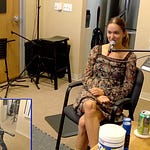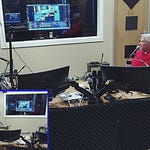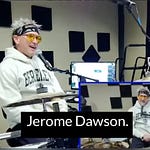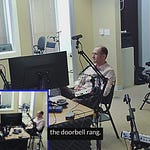Deep Dive Summary (ala NotebookLM)
Audio Version (ala Eleven Labs)
Steve and Knut Madden, the founder of Biogrammatics, delve into their careers, highlighting instances where serendipity played a pivotal role in shaping their paths. Below are excerpts from their conversation.
Summary
In this segment, Steve and Knut discuss their educational journeys and career paths. Knut shares that he was recruited to play football at UC Davis. Initially, he had planned to study engineering, influenced by his father’s background as an engineer and his own aptitude for math. However, he struggled with engineering courses and decided to explore other subjects. A chance anatomy class introduced by his roommate sparked his interest in physiology. Working with cadavers in this class captivated him, leading him to switch his major to physiology and eventually minor in exercise physiology. Knut spent a significant amount of time at Hickey Gym, both for football practice and assisting graduate students with exercise physiology research, further deepening his passion for the field.
Steve relates to Knut’s experience, sharing that he also made a similar switch from chemical engineering to engineering chemistry, thanks to the recommendation of a professor who recognized his genuine interest in chemistry. Both reflect on the importance of guidance from mentors and the role of serendipitous experiences in shaping their educational paths and career interests. Knut concludes that his father’s influence and the structured, rigorous environment at UC Davis provided a solid foundation that, combined with his interests in anatomy and physiology, ultimately guided him toward his chosen field.
Summary
In this podcast segment, Knut and Steve share pivotal career moments that were shaped by serendipity and their diverse interests.
Knut recounts his journey into the biotech field. After earning a degree in physiology, he followed his girlfriend to San Diego, only to find himself jobless and single. Following his father’s advice to seek employment, Knut applied to various places, including the Salk Institute (SIBIA). A receptionist took a chance on him and offered him a job as a stockroom assistant in a biotech company. Through interactions with scientists, Knut became fascinated with molecular biology. This experience led him from exercise physiology to a focus on molecular research, ultimately motivating him to pursue graduate school with the goal of leading his own research someday.
Steve reflects on his own career pivot from chemical engineering to engineering chemistry. He suggested a similar shift to a friend, which opened a door to a research assistant position in a mass spectrometry lab. There, he merged his chemistry knowledge with computer science, applying neural networks to complex chemical data. This innovative combination set him apart and helped him secure a spot in UC Berkeley’s PhD program, despite coming from a small engineering school. Steve’s computational approach was rare at the time, allowing him to complete his PhD quickly, publish widely, and attend conferences. Both Knut and Steve emphasize how unexpected career shifts and interdisciplinary work created unique paths to success.
Summary
In this podcast segment, Steve encourages Knut to share another instance where his training aided him in recognizing and pursuing a valuable opportunity. Knut recounts his decision to join Invitrogen, a small biotech company with 150 employees that later expanded significantly to approximately 5,000, primarily through acquisitions. Unlike a traditional pharmaceutical role focused on a single drug, Invitrogen allowed Knut to work on 10-20 different kits, interacting with teams from various departments, such as R&D, manufacturing, and marketing. This comprehensive view of biotech operations ultimately prepared him for the launch of his own company.
Steve draws parallels between Knut’s experience and his own time at Molecular Design (MDL), a tools-based company with a near-monopoly on chemical structure databases for pharmaceutical, agricultural, and chemical companies. Working at MDL provided Steve with exposure to numerous therapeutic areas and project challenges across multiple companies, akin to mini-internships with each client. He shares Knut’s sentiment, advising young professionals to consider smaller or startup environments for the diverse and hands-on experience they offer. This experience can condense decades’ worth of career exposure into a few years.
Summary
In this segment, Knut asks Steve about his transition into business development. Steve explains that his shift began at Molecular Design (MDL), where he joined before completing his PhD. While still finalizing his thesis, MDL hired him for a marketing role to promote their new technology, ISIS—a database system for desktops. Steve gained valuable business exposure early on by traveling frequently for presentations and handling deals of various scales.
One notable experience was MDL’s collaboration with IBM to adapt their software for IBM’s AIX platform. Although this project wasn’t widely adopted, it positioned MDL to expand to other UNIX systems, ultimately leading to broader compatibility with Linux, which later became globally dominant. This strategic expansion provided Steve with deep business development experience with new ventures, laying the groundwork for his future career.
The Nobel prize in Chemistry this year (October 2024) went to Demis Hassabis, John Jumper and David Baker who brought protein structure prediction to the next level. The prize in physics this year went to Hopfield and Hinton who developed foundational methods for powerful machine learning. Goes to show you how long this stuff takes. Below was my PhD in 1991: Funny, I had a line in my intro that said those who can predict structure from sequence will undoubtedly win a Nobel. My research advisor - Sung Hou Kim (SHK) demanded I strike it. Stubborn, rule-breaking, 20-something me disregarded that input and put the sentence back post "edit" and pre-signoff. It was just a little relocation to escape attention…Summary
In this discussion, Knut and Steve delve into how serendipitous connections and genuine interests have positively impacted their careers. Knut reminisces about meeting former colleagues from his previous jobs, particularly at Invitrogen, where he unexpectedly stumbled upon a project based on his prior work. This unexpected encounter helped secure his position. Knut emphasizes that when individuals are genuinely engaged in their work and interact with like-minded people, meaningful connections can emerge that shape their career trajectories over time. Steve concurs, highlighting that networking without an agenda fosters lasting connections and opportunities. He shares an example of his daughter, Lili, who maintained connections from internships that later aided her in securing multiple jobs.
Steve also shares how he integrates diverse interests, such as podcasting and music mixing, not for financial gain but to enrich his life and potentially benefit others. He underscores the significance of authenticity, a lesson he recently learned from a podcast guest who advised that true success stems from being genuine rather than attempting to create a hit. Both Knut and Steve agree that genuine interactions and community-building efforts, like Knut’s former biotech softball league, often create opportunities that surpass intentionally forced networking. They conclude by reflecting on their shared interest in music and academics, noting how skills like persistence and creativity in music can resonate well in professional and academic pursuits.
Summary
In this segment, Steve delves into his drumming philosophy, highlighting its mathematical underpinnings. This mathematical approach enables him to play unfamiliar songs by identifying patterns rather than relying solely on memory. This preference for spontaneity is a cornerstone of his music mix sessions, where he often joins rhythms initiated by others and relishes collaborating with musicians who haven’t played together or even with the songs themselves. This improvisational style keeps his mind sharp, especially considering that he manages both mixing and drumming in a studio brimming with equipment.
Knut drew parallels between Steve’s dynamic, collaborative approach in music and his work in fields such as AI, drug discovery, and modeling. In these domains, creativity and spontaneity emerge when diverse elements and people are brought together to witness the organic unfolding of ideas.
Credits: Video editing used Pictory.ai
For a music clip, during a recent mix-n-match session, Rick threw at the group a fun Beatles song - I’ve Just Seen a Face. As usual, a new mix of folk never having played the song together, and for some of us the first time even trying it. I thought this might align with the serendipity theme of the pod. This segment with Rick (lead vocals), Jesse (e-guitar, vocals), and Dan (acoustic-guitar/vocals), and Alan (Bass). Substack again seems to mute the first few seconds, so hang in there…:














Share this post